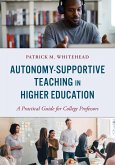Patrick M. Whitehead
Autonomy-Supportive Teaching in Higher Education
A Practical Guide for College Professors
Patrick M. Whitehead
Autonomy-Supportive Teaching in Higher Education
A Practical Guide for College Professors
- Gebundenes Buch
- Merkliste
- Auf die Merkliste
- Bewerten Bewerten
- Teilen
- Produkt teilen
- Produkterinnerung
- Produkterinnerung
This book is for college faculty who are tired of student apathy, disinterest, and confrontation, and who are interested in helping their students cultivate inner motivational resources. Autonomous learners are interested in more than getting a good grade or doing as they're told-they benefit from the motivations that increase need satisfaction, lead to lifelong learning, and support a wide variety of independent learning objectives. Using everyday language, Autonomy-Supportive Teaching in Higher Education: A Practical Guide for College Professors synthesizes the mountain of research conducted…mehr
Andere Kunden interessierten sich auch für
![Autonomy-Supportive Teaching in Higher Education Autonomy-Supportive Teaching in Higher Education]() Patrick M. WhiteheadAutonomy-Supportive Teaching in Higher Education35,99 €
Patrick M. WhiteheadAutonomy-Supportive Teaching in Higher Education35,99 €![Handbook of Research on Advancing Critical Thinking in Higher Education Handbook of Research on Advancing Critical Thinking in Higher Education]() Handbook of Research on Advancing Critical Thinking in Higher Education353,99 €
Handbook of Research on Advancing Critical Thinking in Higher Education353,99 €![Higher education autonomy and public quality assurance Higher education autonomy and public quality assurance]() Bártolo CamposHigher education autonomy and public quality assurance35,99 €
Bártolo CamposHigher education autonomy and public quality assurance35,99 €![Balance and Boundaries in Creating Meaningful Relationships in Online Higher Education Balance and Boundaries in Creating Meaningful Relationships in Online Higher Education]() Balance and Boundaries in Creating Meaningful Relationships in Online Higher Education235,99 €
Balance and Boundaries in Creating Meaningful Relationships in Online Higher Education235,99 €![Balance and Boundaries in Creating Meaningful Relationships in Online Higher Education Balance and Boundaries in Creating Meaningful Relationships in Online Higher Education]() Balance and Boundaries in Creating Meaningful Relationships in Online Higher Education178,99 €
Balance and Boundaries in Creating Meaningful Relationships in Online Higher Education178,99 €![Assessment, Testing, and Measurement Strategies in Global Higher Education Assessment, Testing, and Measurement Strategies in Global Higher Education]() Assessment, Testing, and Measurement Strategies in Global Higher Education220,99 €
Assessment, Testing, and Measurement Strategies in Global Higher Education220,99 €![Cognitive Styles, Study Habits and Academic Achievement Cognitive Styles, Study Habits and Academic Achievement]() Ismail ThamarasseriCognitive Styles, Study Habits and Academic Achievement56,99 €
Ismail ThamarasseriCognitive Styles, Study Habits and Academic Achievement56,99 €-
-
-
This book is for college faculty who are tired of student apathy, disinterest, and confrontation, and who are interested in helping their students cultivate inner motivational resources. Autonomous learners are interested in more than getting a good grade or doing as they're told-they benefit from the motivations that increase need satisfaction, lead to lifelong learning, and support a wide variety of independent learning objectives. Using everyday language, Autonomy-Supportive Teaching in Higher Education: A Practical Guide for College Professors synthesizes the mountain of research conducted using autonomy-supportive teaching (AST) in the classroom. This book summaries the state-of-the-art motivation psychology for the classroom, provides eight workshops demonstrating evidence-based and classroom tested strategies for applying AST, and explores faculty and student reflections on the strengths and weaknesses of AST. With this text, readers can begin applying the principles of self-determination theory to their classrooms today.
Hinweis: Dieser Artikel kann nur an eine deutsche Lieferadresse ausgeliefert werden.
Hinweis: Dieser Artikel kann nur an eine deutsche Lieferadresse ausgeliefert werden.
Produktdetails
- Produktdetails
- Verlag: Rowman & Littlefield Publishers
- Seitenzahl: 178
- Erscheinungstermin: 15. April 2023
- Englisch
- Abmessung: 260mm x 183mm x 14mm
- Gewicht: 541g
- ISBN-13: 9781538177198
- ISBN-10: 1538177196
- Artikelnr.: 66351151
- Herstellerkennzeichnung
- Libri GmbH
- Europaallee 1
- 36244 Bad Hersfeld
- gpsr@libri.de
- Verlag: Rowman & Littlefield Publishers
- Seitenzahl: 178
- Erscheinungstermin: 15. April 2023
- Englisch
- Abmessung: 260mm x 183mm x 14mm
- Gewicht: 541g
- ISBN-13: 9781538177198
- ISBN-10: 1538177196
- Artikelnr.: 66351151
- Herstellerkennzeichnung
- Libri GmbH
- Europaallee 1
- 36244 Bad Hersfeld
- gpsr@libri.de
By Patrick M. Whitehead
Acknowledgments
Introduction
Not a Vignette
A Revolution in My Teaching Spirit
AST Will Work for You and Your Students
Three Potential Hurdles: Mistaken Beliefs that Interfere with Professional
Development
* Mistaken Belief 1: It's the Students' Fault
* Mistaken Belief 2: Teachers Cannot Change
* Mistaken Belief 3: Controlling Teachers Are the Best Teachers
Relation to Other Psychologies of Student Motivation
* Grit: Passion and Determination with Angela Duckworth and Cal Newport
* Fixed and Growth Mindsets with Carol Dweck
* Why We Learn the Ways that We Learn, with Josh Eyler
Structure of this Book
Part I: Theory
Chapter 1: Self-Determination Theory
A Brief History of the Psychology of Student Motivation
Self Determination Theory and the Three Basic Psychological Needs
* Autonomy
* Competence
* Relatedness
* Supporting Basic Psychological Needs
* Why the Students Wouldn't Read Macbeth
The Many Forms of Extrinsic Motivation
* Continuum of Extrinsic Motivation
Internalization and the Regulation of Beliefs, Values, and Behaviors
1. No Regulation of Beliefs, Values, and Behaviors
2. External Regulation of Beliefs, Values, and Behaviors
* Externalized Regulation
* Introjected Regulation
3. Internalized Regulation of Beliefs, Values, and Behaviors
* Identified Regulation
* Integrated Regulation
4. Intrinsic Regulation of Beliefs, Values, and Behaviors
Chapter 2: Autonomy Supportive Teaching
Vignette 1, Where Online Students Missed the First Deadline
Vignette 2, The One with Lethargic Graduate Students
Autonomy Supportive Teaching
Seven Strategies for Supporting Student Autonomy
5. Strategy 1: Autonomy Supportive Teachers Adopt their Students' Perspective
* My Experience Taking Students' Perspective
6. Strategy 2: Autonomy Supportive Teachers Invite Students to Pursue their
Interests
* My Experience Inviting Students to Pursue their Interests
7. Strategy 3: Autonomy Supportive Teachers Present Learning Activities in
Need Satisfying Ways
* Autonomy
* Competence
* Relatedness
* My Experience Presenting Learning Activities in Need-Satisfying Ways
8. Strategy 4: Autonomy Supportive Teachers Provide Explanatory Rationale
* My Experience Providing Explanatory Rationale
9. Strategy 5: Autonomy Supportive Teachers Acknowledge Negative Feelings
* My Experience Acknowledging Negative Feelings
10. Strategy 6: Autonomy Supportive Teachers Use Invitational Language
* My Experience Using Invitational Language
11. Strategy 7: Autonomy Supportive Teachers Practice Patience
* My Experience Practicing Patience
The Gestalt of Autonomy Supportive Teaching
Chapter 3: Evidence Supporting Autonomy Supportive Teaching in Higher
Education
Evidence that AST Works in Higher Education
* Physical Education and Other General Education Courses
* Remedial Writing Courses
* Music and Performing Arts
* Psychology and Social Sciences
* Sciences and Liberal Arts in South America
* Arts and Humanities, Health Sciences, Engineering, and Exercise
Sciences in Europe
* Online and Asynchronous Courses
* Graduate School
* Gender Differences in Highly Specific Cases
Intercultural and International Applicability
Conclusion
Part II: Application
Chapter 4: Self-Determination Theory Workshop
Basic Psychological Needs
Regulation of Beliefs, Values, and Behaviors
Chapter 5: Assessing Autonomy Supportive Teaching Workshop
A Preliminary Note on the Difference Between Assessment and Evaluation
Situations in School Inventory
* Assessing Structure
* Assessing Chaos
* Assessing Autonomy Support
* Assessing Control
* Completing the Inventory and Analyzing the Results
Situations in School Inventory
* Scoring
* Advanced Scoring
Learning Climate Questionnaire
Classroom Observation Checksheet
Chapter 6: Taking Students' Perspective Workshop
Methods for Getting Student Feedback
* Distribute Slips of Paper Asking for Anonymous Suggestions
* Hold an Open "Town Hall" Type Forum
* Create a Virtual Survey or Poll
When to Avoid Taking Students' Perspective
Put It into Practice
* Homework Activity #1: Distribute Comment Cards
* Homework Activity #2: Seek Candid Reviews of Course Content
* Homework Activity #3: Invite Students to Comment on Lesson Plan for
the Day
Problems to Expect, and How to Deal with Them
* Students Have No Feedback to Share
* Students Don't Seem to Be Interested in Their Own Suggestions
* Students Have Only Positive Feedback to Share
Chapter 7: Supporting Students' Intrinsic Motivation Workshop
AST Strategy Two: Invite Students to Pursue Their Interests
* Homework: Identify an Aspect of the Course with Which You Are
Comfortable Allowing Students to Participate in Choosing
AST Strategy Three: Present Learning Activities in Need-Satisfying Ways
12. Competence
13. Relatedness
14. Put it Into Practice
* Homework Activity #1: Stop and Assess Where Your Students Are
* Homework Activity #2: Emphasize Relatedness by Encouraging Students
to Work Together
15. Problems to Expect and How to Deal with Them
* Students Have a Range of Skill Levels
* Students Are Not Interested in Working Together
Chapter 8: Supporting Students' Internalization Workshop
AST Strategy Four: Provide Explanatory Rationale
16. Put it into Practice
* Homework Activity #1: Explain Why You're Doing the Next Thing You
Will Be Doing
* Homework Activity #2: Integrate Rationale into Assignment
Instructions
* Homework Activity #3: Explore the TiLT Model of Teaching
AST Strategy Five: Acknowledge Negative Feelings
* Homework Activity #1: Acknowledge and Accept the Negative Affect of
One Student
* Homework Activity #2: Use Collective Negative Affect as a Diagnostic
Tool
* Homework Activity #3: Reflect on the Ideal Emotional Profile of
Students
AST Strategy Six: Rely on Invitational Language
* Homework Activity #1: Rewrite Activity Instructions Using
Invitational Language
* Homework Activity #2: Design an Alternative Assignment
AST Strategy Seven: Practice Patience
* Homework Activity #1: Adjust the Amount of Time Needed for Completing
an Activity
* Homework Activity #2: Patient Listening
Part III: Finishing Touches
Chapter 9: Sample Assessment: Using AST in Online Courses
AST in Online Courses: An Understudied Relationship
Design
* Control Condition
* AST Condition
* List of Sample Activities for AST Condition (Human Growth and
Development)
Results
* Learning Climate Inventory
Discussion
Additional Results
Student Comments about the AST Condition
Discussion of Assessment Results
* Mistake Number 1: Expectations Were Unclear
* Mistake Number 2: My Understanding of AST Was Limited
* Mistake Number 3: I integrated Too Few AST Strategies
Conclusion
Chapter 10: A Case Study of Teacher Transformation
My 2016 Letter to Students
* Course "Deliverables"
* Desire2Learn
* Be Yourself
My 2022 Analysis of the 2016 Letter to Students
* The Letter is Long
* The Letter is Formatted Using Headings
* There is a Block Quote
* The Letter is Not Written from the Students' Perspective
* Students Are Expected to Be Guided by Intrinsic Motivation
* There is Little Explanatory Rationale
* There is No Room for Affect
* It's My Way or the Highway
* Selective Patience
* It Isn't All Bad
A Digital Letter Written to an Online Health Psychology Course in 2022
* General Observations
Conclusion: Troubleshooting Problems and Looking Ahead
Some Instructors Will Do This Naturally
Anticipating Problems
* The Need for Structure
* Logistical Problems with Adopting Autonomy Supportive Teaching
* Confusion about What the Strategies Entail
* Disagreement about the Teachability of Certain Strategies
* External Pressures to Be Controlling
A Call for More Research on AST in Higher Education
AST in Large Lecture Halls (Less than 70 students)
Asynchronous Online Courses
Professional and Organizational Development
References
Index
About the Author
Introduction
Not a Vignette
A Revolution in My Teaching Spirit
AST Will Work for You and Your Students
Three Potential Hurdles: Mistaken Beliefs that Interfere with Professional
Development
* Mistaken Belief 1: It's the Students' Fault
* Mistaken Belief 2: Teachers Cannot Change
* Mistaken Belief 3: Controlling Teachers Are the Best Teachers
Relation to Other Psychologies of Student Motivation
* Grit: Passion and Determination with Angela Duckworth and Cal Newport
* Fixed and Growth Mindsets with Carol Dweck
* Why We Learn the Ways that We Learn, with Josh Eyler
Structure of this Book
Part I: Theory
Chapter 1: Self-Determination Theory
A Brief History of the Psychology of Student Motivation
Self Determination Theory and the Three Basic Psychological Needs
* Autonomy
* Competence
* Relatedness
* Supporting Basic Psychological Needs
* Why the Students Wouldn't Read Macbeth
The Many Forms of Extrinsic Motivation
* Continuum of Extrinsic Motivation
Internalization and the Regulation of Beliefs, Values, and Behaviors
1. No Regulation of Beliefs, Values, and Behaviors
2. External Regulation of Beliefs, Values, and Behaviors
* Externalized Regulation
* Introjected Regulation
3. Internalized Regulation of Beliefs, Values, and Behaviors
* Identified Regulation
* Integrated Regulation
4. Intrinsic Regulation of Beliefs, Values, and Behaviors
Chapter 2: Autonomy Supportive Teaching
Vignette 1, Where Online Students Missed the First Deadline
Vignette 2, The One with Lethargic Graduate Students
Autonomy Supportive Teaching
Seven Strategies for Supporting Student Autonomy
5. Strategy 1: Autonomy Supportive Teachers Adopt their Students' Perspective
* My Experience Taking Students' Perspective
6. Strategy 2: Autonomy Supportive Teachers Invite Students to Pursue their
Interests
* My Experience Inviting Students to Pursue their Interests
7. Strategy 3: Autonomy Supportive Teachers Present Learning Activities in
Need Satisfying Ways
* Autonomy
* Competence
* Relatedness
* My Experience Presenting Learning Activities in Need-Satisfying Ways
8. Strategy 4: Autonomy Supportive Teachers Provide Explanatory Rationale
* My Experience Providing Explanatory Rationale
9. Strategy 5: Autonomy Supportive Teachers Acknowledge Negative Feelings
* My Experience Acknowledging Negative Feelings
10. Strategy 6: Autonomy Supportive Teachers Use Invitational Language
* My Experience Using Invitational Language
11. Strategy 7: Autonomy Supportive Teachers Practice Patience
* My Experience Practicing Patience
The Gestalt of Autonomy Supportive Teaching
Chapter 3: Evidence Supporting Autonomy Supportive Teaching in Higher
Education
Evidence that AST Works in Higher Education
* Physical Education and Other General Education Courses
* Remedial Writing Courses
* Music and Performing Arts
* Psychology and Social Sciences
* Sciences and Liberal Arts in South America
* Arts and Humanities, Health Sciences, Engineering, and Exercise
Sciences in Europe
* Online and Asynchronous Courses
* Graduate School
* Gender Differences in Highly Specific Cases
Intercultural and International Applicability
Conclusion
Part II: Application
Chapter 4: Self-Determination Theory Workshop
Basic Psychological Needs
Regulation of Beliefs, Values, and Behaviors
Chapter 5: Assessing Autonomy Supportive Teaching Workshop
A Preliminary Note on the Difference Between Assessment and Evaluation
Situations in School Inventory
* Assessing Structure
* Assessing Chaos
* Assessing Autonomy Support
* Assessing Control
* Completing the Inventory and Analyzing the Results
Situations in School Inventory
* Scoring
* Advanced Scoring
Learning Climate Questionnaire
Classroom Observation Checksheet
Chapter 6: Taking Students' Perspective Workshop
Methods for Getting Student Feedback
* Distribute Slips of Paper Asking for Anonymous Suggestions
* Hold an Open "Town Hall" Type Forum
* Create a Virtual Survey or Poll
When to Avoid Taking Students' Perspective
Put It into Practice
* Homework Activity #1: Distribute Comment Cards
* Homework Activity #2: Seek Candid Reviews of Course Content
* Homework Activity #3: Invite Students to Comment on Lesson Plan for
the Day
Problems to Expect, and How to Deal with Them
* Students Have No Feedback to Share
* Students Don't Seem to Be Interested in Their Own Suggestions
* Students Have Only Positive Feedback to Share
Chapter 7: Supporting Students' Intrinsic Motivation Workshop
AST Strategy Two: Invite Students to Pursue Their Interests
* Homework: Identify an Aspect of the Course with Which You Are
Comfortable Allowing Students to Participate in Choosing
AST Strategy Three: Present Learning Activities in Need-Satisfying Ways
12. Competence
13. Relatedness
14. Put it Into Practice
* Homework Activity #1: Stop and Assess Where Your Students Are
* Homework Activity #2: Emphasize Relatedness by Encouraging Students
to Work Together
15. Problems to Expect and How to Deal with Them
* Students Have a Range of Skill Levels
* Students Are Not Interested in Working Together
Chapter 8: Supporting Students' Internalization Workshop
AST Strategy Four: Provide Explanatory Rationale
16. Put it into Practice
* Homework Activity #1: Explain Why You're Doing the Next Thing You
Will Be Doing
* Homework Activity #2: Integrate Rationale into Assignment
Instructions
* Homework Activity #3: Explore the TiLT Model of Teaching
AST Strategy Five: Acknowledge Negative Feelings
* Homework Activity #1: Acknowledge and Accept the Negative Affect of
One Student
* Homework Activity #2: Use Collective Negative Affect as a Diagnostic
Tool
* Homework Activity #3: Reflect on the Ideal Emotional Profile of
Students
AST Strategy Six: Rely on Invitational Language
* Homework Activity #1: Rewrite Activity Instructions Using
Invitational Language
* Homework Activity #2: Design an Alternative Assignment
AST Strategy Seven: Practice Patience
* Homework Activity #1: Adjust the Amount of Time Needed for Completing
an Activity
* Homework Activity #2: Patient Listening
Part III: Finishing Touches
Chapter 9: Sample Assessment: Using AST in Online Courses
AST in Online Courses: An Understudied Relationship
Design
* Control Condition
* AST Condition
* List of Sample Activities for AST Condition (Human Growth and
Development)
Results
* Learning Climate Inventory
Discussion
Additional Results
Student Comments about the AST Condition
Discussion of Assessment Results
* Mistake Number 1: Expectations Were Unclear
* Mistake Number 2: My Understanding of AST Was Limited
* Mistake Number 3: I integrated Too Few AST Strategies
Conclusion
Chapter 10: A Case Study of Teacher Transformation
My 2016 Letter to Students
* Course "Deliverables"
* Desire2Learn
* Be Yourself
My 2022 Analysis of the 2016 Letter to Students
* The Letter is Long
* The Letter is Formatted Using Headings
* There is a Block Quote
* The Letter is Not Written from the Students' Perspective
* Students Are Expected to Be Guided by Intrinsic Motivation
* There is Little Explanatory Rationale
* There is No Room for Affect
* It's My Way or the Highway
* Selective Patience
* It Isn't All Bad
A Digital Letter Written to an Online Health Psychology Course in 2022
* General Observations
Conclusion: Troubleshooting Problems and Looking Ahead
Some Instructors Will Do This Naturally
Anticipating Problems
* The Need for Structure
* Logistical Problems with Adopting Autonomy Supportive Teaching
* Confusion about What the Strategies Entail
* Disagreement about the Teachability of Certain Strategies
* External Pressures to Be Controlling
A Call for More Research on AST in Higher Education
AST in Large Lecture Halls (Less than 70 students)
Asynchronous Online Courses
Professional and Organizational Development
References
Index
About the Author
Acknowledgments
Introduction
Not a Vignette
A Revolution in My Teaching Spirit
AST Will Work for You and Your Students
Three Potential Hurdles: Mistaken Beliefs that Interfere with Professional
Development
* Mistaken Belief 1: It's the Students' Fault
* Mistaken Belief 2: Teachers Cannot Change
* Mistaken Belief 3: Controlling Teachers Are the Best Teachers
Relation to Other Psychologies of Student Motivation
* Grit: Passion and Determination with Angela Duckworth and Cal Newport
* Fixed and Growth Mindsets with Carol Dweck
* Why We Learn the Ways that We Learn, with Josh Eyler
Structure of this Book
Part I: Theory
Chapter 1: Self-Determination Theory
A Brief History of the Psychology of Student Motivation
Self Determination Theory and the Three Basic Psychological Needs
* Autonomy
* Competence
* Relatedness
* Supporting Basic Psychological Needs
* Why the Students Wouldn't Read Macbeth
The Many Forms of Extrinsic Motivation
* Continuum of Extrinsic Motivation
Internalization and the Regulation of Beliefs, Values, and Behaviors
1. No Regulation of Beliefs, Values, and Behaviors
2. External Regulation of Beliefs, Values, and Behaviors
* Externalized Regulation
* Introjected Regulation
3. Internalized Regulation of Beliefs, Values, and Behaviors
* Identified Regulation
* Integrated Regulation
4. Intrinsic Regulation of Beliefs, Values, and Behaviors
Chapter 2: Autonomy Supportive Teaching
Vignette 1, Where Online Students Missed the First Deadline
Vignette 2, The One with Lethargic Graduate Students
Autonomy Supportive Teaching
Seven Strategies for Supporting Student Autonomy
5. Strategy 1: Autonomy Supportive Teachers Adopt their Students' Perspective
* My Experience Taking Students' Perspective
6. Strategy 2: Autonomy Supportive Teachers Invite Students to Pursue their
Interests
* My Experience Inviting Students to Pursue their Interests
7. Strategy 3: Autonomy Supportive Teachers Present Learning Activities in
Need Satisfying Ways
* Autonomy
* Competence
* Relatedness
* My Experience Presenting Learning Activities in Need-Satisfying Ways
8. Strategy 4: Autonomy Supportive Teachers Provide Explanatory Rationale
* My Experience Providing Explanatory Rationale
9. Strategy 5: Autonomy Supportive Teachers Acknowledge Negative Feelings
* My Experience Acknowledging Negative Feelings
10. Strategy 6: Autonomy Supportive Teachers Use Invitational Language
* My Experience Using Invitational Language
11. Strategy 7: Autonomy Supportive Teachers Practice Patience
* My Experience Practicing Patience
The Gestalt of Autonomy Supportive Teaching
Chapter 3: Evidence Supporting Autonomy Supportive Teaching in Higher
Education
Evidence that AST Works in Higher Education
* Physical Education and Other General Education Courses
* Remedial Writing Courses
* Music and Performing Arts
* Psychology and Social Sciences
* Sciences and Liberal Arts in South America
* Arts and Humanities, Health Sciences, Engineering, and Exercise
Sciences in Europe
* Online and Asynchronous Courses
* Graduate School
* Gender Differences in Highly Specific Cases
Intercultural and International Applicability
Conclusion
Part II: Application
Chapter 4: Self-Determination Theory Workshop
Basic Psychological Needs
Regulation of Beliefs, Values, and Behaviors
Chapter 5: Assessing Autonomy Supportive Teaching Workshop
A Preliminary Note on the Difference Between Assessment and Evaluation
Situations in School Inventory
* Assessing Structure
* Assessing Chaos
* Assessing Autonomy Support
* Assessing Control
* Completing the Inventory and Analyzing the Results
Situations in School Inventory
* Scoring
* Advanced Scoring
Learning Climate Questionnaire
Classroom Observation Checksheet
Chapter 6: Taking Students' Perspective Workshop
Methods for Getting Student Feedback
* Distribute Slips of Paper Asking for Anonymous Suggestions
* Hold an Open "Town Hall" Type Forum
* Create a Virtual Survey or Poll
When to Avoid Taking Students' Perspective
Put It into Practice
* Homework Activity #1: Distribute Comment Cards
* Homework Activity #2: Seek Candid Reviews of Course Content
* Homework Activity #3: Invite Students to Comment on Lesson Plan for
the Day
Problems to Expect, and How to Deal with Them
* Students Have No Feedback to Share
* Students Don't Seem to Be Interested in Their Own Suggestions
* Students Have Only Positive Feedback to Share
Chapter 7: Supporting Students' Intrinsic Motivation Workshop
AST Strategy Two: Invite Students to Pursue Their Interests
* Homework: Identify an Aspect of the Course with Which You Are
Comfortable Allowing Students to Participate in Choosing
AST Strategy Three: Present Learning Activities in Need-Satisfying Ways
12. Competence
13. Relatedness
14. Put it Into Practice
* Homework Activity #1: Stop and Assess Where Your Students Are
* Homework Activity #2: Emphasize Relatedness by Encouraging Students
to Work Together
15. Problems to Expect and How to Deal with Them
* Students Have a Range of Skill Levels
* Students Are Not Interested in Working Together
Chapter 8: Supporting Students' Internalization Workshop
AST Strategy Four: Provide Explanatory Rationale
16. Put it into Practice
* Homework Activity #1: Explain Why You're Doing the Next Thing You
Will Be Doing
* Homework Activity #2: Integrate Rationale into Assignment
Instructions
* Homework Activity #3: Explore the TiLT Model of Teaching
AST Strategy Five: Acknowledge Negative Feelings
* Homework Activity #1: Acknowledge and Accept the Negative Affect of
One Student
* Homework Activity #2: Use Collective Negative Affect as a Diagnostic
Tool
* Homework Activity #3: Reflect on the Ideal Emotional Profile of
Students
AST Strategy Six: Rely on Invitational Language
* Homework Activity #1: Rewrite Activity Instructions Using
Invitational Language
* Homework Activity #2: Design an Alternative Assignment
AST Strategy Seven: Practice Patience
* Homework Activity #1: Adjust the Amount of Time Needed for Completing
an Activity
* Homework Activity #2: Patient Listening
Part III: Finishing Touches
Chapter 9: Sample Assessment: Using AST in Online Courses
AST in Online Courses: An Understudied Relationship
Design
* Control Condition
* AST Condition
* List of Sample Activities for AST Condition (Human Growth and
Development)
Results
* Learning Climate Inventory
Discussion
Additional Results
Student Comments about the AST Condition
Discussion of Assessment Results
* Mistake Number 1: Expectations Were Unclear
* Mistake Number 2: My Understanding of AST Was Limited
* Mistake Number 3: I integrated Too Few AST Strategies
Conclusion
Chapter 10: A Case Study of Teacher Transformation
My 2016 Letter to Students
* Course "Deliverables"
* Desire2Learn
* Be Yourself
My 2022 Analysis of the 2016 Letter to Students
* The Letter is Long
* The Letter is Formatted Using Headings
* There is a Block Quote
* The Letter is Not Written from the Students' Perspective
* Students Are Expected to Be Guided by Intrinsic Motivation
* There is Little Explanatory Rationale
* There is No Room for Affect
* It's My Way or the Highway
* Selective Patience
* It Isn't All Bad
A Digital Letter Written to an Online Health Psychology Course in 2022
* General Observations
Conclusion: Troubleshooting Problems and Looking Ahead
Some Instructors Will Do This Naturally
Anticipating Problems
* The Need for Structure
* Logistical Problems with Adopting Autonomy Supportive Teaching
* Confusion about What the Strategies Entail
* Disagreement about the Teachability of Certain Strategies
* External Pressures to Be Controlling
A Call for More Research on AST in Higher Education
AST in Large Lecture Halls (Less than 70 students)
Asynchronous Online Courses
Professional and Organizational Development
References
Index
About the Author
Introduction
Not a Vignette
A Revolution in My Teaching Spirit
AST Will Work for You and Your Students
Three Potential Hurdles: Mistaken Beliefs that Interfere with Professional
Development
* Mistaken Belief 1: It's the Students' Fault
* Mistaken Belief 2: Teachers Cannot Change
* Mistaken Belief 3: Controlling Teachers Are the Best Teachers
Relation to Other Psychologies of Student Motivation
* Grit: Passion and Determination with Angela Duckworth and Cal Newport
* Fixed and Growth Mindsets with Carol Dweck
* Why We Learn the Ways that We Learn, with Josh Eyler
Structure of this Book
Part I: Theory
Chapter 1: Self-Determination Theory
A Brief History of the Psychology of Student Motivation
Self Determination Theory and the Three Basic Psychological Needs
* Autonomy
* Competence
* Relatedness
* Supporting Basic Psychological Needs
* Why the Students Wouldn't Read Macbeth
The Many Forms of Extrinsic Motivation
* Continuum of Extrinsic Motivation
Internalization and the Regulation of Beliefs, Values, and Behaviors
1. No Regulation of Beliefs, Values, and Behaviors
2. External Regulation of Beliefs, Values, and Behaviors
* Externalized Regulation
* Introjected Regulation
3. Internalized Regulation of Beliefs, Values, and Behaviors
* Identified Regulation
* Integrated Regulation
4. Intrinsic Regulation of Beliefs, Values, and Behaviors
Chapter 2: Autonomy Supportive Teaching
Vignette 1, Where Online Students Missed the First Deadline
Vignette 2, The One with Lethargic Graduate Students
Autonomy Supportive Teaching
Seven Strategies for Supporting Student Autonomy
5. Strategy 1: Autonomy Supportive Teachers Adopt their Students' Perspective
* My Experience Taking Students' Perspective
6. Strategy 2: Autonomy Supportive Teachers Invite Students to Pursue their
Interests
* My Experience Inviting Students to Pursue their Interests
7. Strategy 3: Autonomy Supportive Teachers Present Learning Activities in
Need Satisfying Ways
* Autonomy
* Competence
* Relatedness
* My Experience Presenting Learning Activities in Need-Satisfying Ways
8. Strategy 4: Autonomy Supportive Teachers Provide Explanatory Rationale
* My Experience Providing Explanatory Rationale
9. Strategy 5: Autonomy Supportive Teachers Acknowledge Negative Feelings
* My Experience Acknowledging Negative Feelings
10. Strategy 6: Autonomy Supportive Teachers Use Invitational Language
* My Experience Using Invitational Language
11. Strategy 7: Autonomy Supportive Teachers Practice Patience
* My Experience Practicing Patience
The Gestalt of Autonomy Supportive Teaching
Chapter 3: Evidence Supporting Autonomy Supportive Teaching in Higher
Education
Evidence that AST Works in Higher Education
* Physical Education and Other General Education Courses
* Remedial Writing Courses
* Music and Performing Arts
* Psychology and Social Sciences
* Sciences and Liberal Arts in South America
* Arts and Humanities, Health Sciences, Engineering, and Exercise
Sciences in Europe
* Online and Asynchronous Courses
* Graduate School
* Gender Differences in Highly Specific Cases
Intercultural and International Applicability
Conclusion
Part II: Application
Chapter 4: Self-Determination Theory Workshop
Basic Psychological Needs
Regulation of Beliefs, Values, and Behaviors
Chapter 5: Assessing Autonomy Supportive Teaching Workshop
A Preliminary Note on the Difference Between Assessment and Evaluation
Situations in School Inventory
* Assessing Structure
* Assessing Chaos
* Assessing Autonomy Support
* Assessing Control
* Completing the Inventory and Analyzing the Results
Situations in School Inventory
* Scoring
* Advanced Scoring
Learning Climate Questionnaire
Classroom Observation Checksheet
Chapter 6: Taking Students' Perspective Workshop
Methods for Getting Student Feedback
* Distribute Slips of Paper Asking for Anonymous Suggestions
* Hold an Open "Town Hall" Type Forum
* Create a Virtual Survey or Poll
When to Avoid Taking Students' Perspective
Put It into Practice
* Homework Activity #1: Distribute Comment Cards
* Homework Activity #2: Seek Candid Reviews of Course Content
* Homework Activity #3: Invite Students to Comment on Lesson Plan for
the Day
Problems to Expect, and How to Deal with Them
* Students Have No Feedback to Share
* Students Don't Seem to Be Interested in Their Own Suggestions
* Students Have Only Positive Feedback to Share
Chapter 7: Supporting Students' Intrinsic Motivation Workshop
AST Strategy Two: Invite Students to Pursue Their Interests
* Homework: Identify an Aspect of the Course with Which You Are
Comfortable Allowing Students to Participate in Choosing
AST Strategy Three: Present Learning Activities in Need-Satisfying Ways
12. Competence
13. Relatedness
14. Put it Into Practice
* Homework Activity #1: Stop and Assess Where Your Students Are
* Homework Activity #2: Emphasize Relatedness by Encouraging Students
to Work Together
15. Problems to Expect and How to Deal with Them
* Students Have a Range of Skill Levels
* Students Are Not Interested in Working Together
Chapter 8: Supporting Students' Internalization Workshop
AST Strategy Four: Provide Explanatory Rationale
16. Put it into Practice
* Homework Activity #1: Explain Why You're Doing the Next Thing You
Will Be Doing
* Homework Activity #2: Integrate Rationale into Assignment
Instructions
* Homework Activity #3: Explore the TiLT Model of Teaching
AST Strategy Five: Acknowledge Negative Feelings
* Homework Activity #1: Acknowledge and Accept the Negative Affect of
One Student
* Homework Activity #2: Use Collective Negative Affect as a Diagnostic
Tool
* Homework Activity #3: Reflect on the Ideal Emotional Profile of
Students
AST Strategy Six: Rely on Invitational Language
* Homework Activity #1: Rewrite Activity Instructions Using
Invitational Language
* Homework Activity #2: Design an Alternative Assignment
AST Strategy Seven: Practice Patience
* Homework Activity #1: Adjust the Amount of Time Needed for Completing
an Activity
* Homework Activity #2: Patient Listening
Part III: Finishing Touches
Chapter 9: Sample Assessment: Using AST in Online Courses
AST in Online Courses: An Understudied Relationship
Design
* Control Condition
* AST Condition
* List of Sample Activities for AST Condition (Human Growth and
Development)
Results
* Learning Climate Inventory
Discussion
Additional Results
Student Comments about the AST Condition
Discussion of Assessment Results
* Mistake Number 1: Expectations Were Unclear
* Mistake Number 2: My Understanding of AST Was Limited
* Mistake Number 3: I integrated Too Few AST Strategies
Conclusion
Chapter 10: A Case Study of Teacher Transformation
My 2016 Letter to Students
* Course "Deliverables"
* Desire2Learn
* Be Yourself
My 2022 Analysis of the 2016 Letter to Students
* The Letter is Long
* The Letter is Formatted Using Headings
* There is a Block Quote
* The Letter is Not Written from the Students' Perspective
* Students Are Expected to Be Guided by Intrinsic Motivation
* There is Little Explanatory Rationale
* There is No Room for Affect
* It's My Way or the Highway
* Selective Patience
* It Isn't All Bad
A Digital Letter Written to an Online Health Psychology Course in 2022
* General Observations
Conclusion: Troubleshooting Problems and Looking Ahead
Some Instructors Will Do This Naturally
Anticipating Problems
* The Need for Structure
* Logistical Problems with Adopting Autonomy Supportive Teaching
* Confusion about What the Strategies Entail
* Disagreement about the Teachability of Certain Strategies
* External Pressures to Be Controlling
A Call for More Research on AST in Higher Education
AST in Large Lecture Halls (Less than 70 students)
Asynchronous Online Courses
Professional and Organizational Development
References
Index
About the Author








